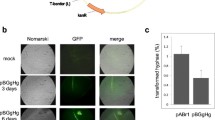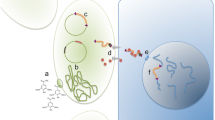Abstract
The list of fungal species with known complete genome and/or expressed sequence tag collections is extending rapidly during the last couple of years. Postgenomic gene function assignment is an obvious follow-up and depends on methodologies to test gene function in vivo. One of such methods is the generation of null mutants via homologous recombination at the wild–type loci by using inactivation cassettes. In this paper, the ability of Agrobacterium tumefaciens to genetically transform filamentous fungi was exploited to drive homologous recombination at the trp1 locus of the enthomopathogenic fungus Metarhizium anisopliae. The trp1 disruptants exhibited a clearly distinguishable phenotype from wild-type cells and were recovered with high efficiency of homologous recombination (22%). The complementation of such mutants with the wild-type gene generates only transformants with homologous integration.



Similar content being viewed by others
References
Arruda W, Lubeck I, Schrank A, Vainstein MH (2005) Morphological alterations of Metarhizium anisopliae during penetration of Boophilus microplus ticks. Exp Appl Acarol 37:231–244
Bird D, Bradshaw R (1997) Gene targeting is locus dependent in the filamentous fungus Aspergillus nidulans. Mol Gen Genet 255:219–225
Bogo MR, Vainstein MH, Aragao FJ, Rech E, Schrank A (1996) High frequency gene conversion among benomyl resistant transformants in the entomopathogenic fungus Metarhizium anisopliae. FEMS Microbiol Lett 142:123–127
Casselton LA, De La Fuente-Herce A (1989) Heterologous gene expression in the basidiomycete Coprinus cinereus. Curr Genet 16:35–40
Combier JP, Melayah D, Raffier C, Gay G, Marmeisse R (2003) Agrobacterium tumefaciens-mediated transformation as a tool for insertional mutagenesis in the symbiotic ectomycorrhizal fungus Hebeloma cylindrosporum. FEMS Microbiol Lett 220:141–148
Covert SF, Kapoor P, Lee M, Briley A, Nairn CJ (2001) Agrobacterium-mediated transformation of Fusarium circinatum. Mycol Res 105:259–264
de Groot MJ, Bundock P, Hooykaas PJ, Beijersbergen AG (1998) Agrobacterium tumefaciens-mediated transformation of filamentous fungi. Nat Biotechnol 16:839–842
Duarte RTD, Staats CC, Fungaro MHP, Schrank A, Vainstein MH, Furlaneto-Maia L, Nakamura CV, Souza W, Furlaneto MC (2007) Development of a simple and rapid Agrobacterium tumefaciens-mediated transformation system for the enthomopathogenic fungus Metarhizium anisopliae var. acridum. Lett Appl Microbiol 44:248–254
Dutra V, Nakazato L, Broetto L, Schrank IS, Vainstein MH, Schrank A (2004) Application of representational difference analysis to identify sequence tags expressed by Metarhizium anisopliae during the infection process of the tick Boophilus microplus cuticle. Res Microbiol 155:245–251
Fang W, Pei Y, Bidochka MJ (2006) Transformation of Metarhizium anisopliae mediated by Agrobacterium tumefaciens. Can J Microbiol 52:623–626
Fang W, Zhang Y, Yang X, Zheng X, Duan H, Li Y, Pei Y (2004) Agrobacterium tumefaciens-mediated transformation of Beauveria bassiana using an herbicide resistance gene as a selection marker. J Invertebr Pathol 85:18–24
Freimoser FM, Screen S, Bagga S, Hu G, St. Leger RJ (2003) Expressed sequence tag (EST) analysis of two subspecies of Metarhizium anisopliae reveals a plethora of secreted proteins with potential activity in insect hosts. Microbiology 149:239–247
Godio RP, Fouces R, Gudina EJ, Martin JF (2004) Agrobacterium tumefaciens-mediated transformation of the antitumor clavaric acid-producing basidiomycete Hypholoma sublateritium. Curr Genet 46:287–294
Goosen T, van Engelenburg F, Debets F, Swart K, Bos K, van den Broek H (1989) Tryptophan auxotrophic mutants in Aspergillus niger: inactivation of the trpC gene by cotransformation mutagenesis. Mol Gen Genet 219:282–288
Hoffman B, Breuil C (2004) Disruption of the subtilase gene, albin1, in Ophiostoma piliferum. Appl Environ Microbiol 70:3898–3903
Holt JG, Krieg NR, Sneath PHA, Staley JT, Williams ST (1994) Bergey’s manual of determinative microbiology. Williams and Wilkins, Maryland
Kassa A, Stephan D, Vidal S, Zimmermann G (2004) Laboratory and field evaluation of different formulations of Metarhizium anisopliae var. acridum submerged spores and aerial conidia for the control locusts and grasshoppers. Biocontrol 49:63–81
Lazzarini GM, Rocha LF, Luz C (2006) Impact of moisture on in vitro germination of Metarhizium anisopliae and Beauveria bassiana and their activity on Triatoma infestans. Mycol Res 110:485–492
Lee MH, Bostock RM (2006) Agrobacterium T-DNA-mediated integration and gene replacement in the brown rot pathogen Monilinia fructicola. Curr Genet 49:309–322
Lima IG, Duarte RT, Furlaneto L, Baroni CH, Fungaro MH, Furlaneto MC (2006) Transformation of the entomopathogenic fungus Paecilomyces fumosoroseus with Agrobacterium tumefaciens. Lett Appl Microbiol 42:631–636
Meyer V, Mueller D, Strowig T, Stahl U (2003) Comparison of different transformation methods for Aspergillus giganteus. Curr Genet 43:371–377
Michielse CB, Arentshorst M, Ram AF, van den Hondel CA (2005a) Agrobacterium–mediated transformation leads to improved gene replacement efficiency in Aspergillus awamori. Fungal Genet Biol 42:9–19
Michielse CB, Hooykaas PJ, van den Hondel CA, Ram AF (2005b) Agrobacterium-mediated transformation as a tool for functional genomics in fungi. Curr Genet 48:1–17
Mullin PG, Turgeon BG, Yoder OC (1993) Complementation of Cochliobolus heterostrophus trp-mutants produced by gene replacement. Fungal Genet Newsl 40:51–53
Nakazato L, Dutra V, Broetto L, Staats CC, Vainstein MH, Schrank A (2006) Development of an expression vector for Metarhizium anisopliae based on the tef-1alpha homologous promoter. Appl Microbiol Biotechnol 72:521–528
Rauyaree P, Ospina-Giraldo MD, Kang S, Bhat RG, Subbarao KV, Grant SJ, Dobinson KF (2005) Mutations in VMK1, a mitogen-activated protein kinase gene, affect microsclerotia formation and pathogenicity in Verticillium dahliae. Curr Genet 48:109–116
Ruiz-Díez B (2002) Strategies for the transformation of filamentous fungi. J Appl Microbiol 92:189–195
Sambrook J, Russel DW (2001) Molecular cloning: a laboratory manual, 3rd edn. Cold Spring Harbor Laboratory, Cold Spring Harbor, NY
Scholte EJ, Knols BG, Takken W (2006) Autodissemination of the entomopathogenic fungus Metarhizium anisopliae amongst adults of the malaria vector Anopheles gambiae s.s. Malar J 283:45
St. Leger R, Shimizu S, Joshi L, Bidochka MJ, Roberts DW (1995) Co-transformation of Metarhizium anisopliae by electroporation or using the gene gun to produce stable GUS transformants. FEMS Microbiol Lett 131:289–294
Staats CC, Silva MS, Pinto PM, Vainstein MH, Schrank A (2004) The Metarhizium anisopliae trp1 gene: cloning and regulatory analysis. Curr Microbiol 49:66–70
Sugui JA, Chang YC, Kwon-Chung KJ (2005) Agrobacterium tumefaciens–mediated transformation of Aspergillus fumigatus: an efficient tool for insertional mutagenesis and targeted gene disruption. Appl Environ Microbiol 71:1798–1802
Wang C, Hu G, St. Leger RJ (2005) Differential gene expression by Metarhizium anisopliae growing in root exudate and host (Manduca sexta) cuticle or hemolymph reveals mechanisms of physiological adaptation. Fungal Genet Biol 42:704–718
Weld RJ, Plummer KM, Carpenter MA, Ridgway HJ (2006) Approaches to functional genomics in filamentous fungi. Cell Res 16:31–44
Acknowledgements
This work was supported by grants from CNPq, CAPES, and FAPERGS. The authors wish to thank W. Arruda for the SEM and the PIGS sequencing network at the CBiot-UFRGS. The authors thank G.H.Goldman and A. Zaha for critically reading of the manuscript.
Author information
Authors and Affiliations
Corresponding author
Rights and permissions
About this article
Cite this article
Staats, C.C., Junges, A., Fitarelli, M. et al. Gene inactivation mediated by Agrobacterium tumefaciens in the filamentous fungi Metarhizium anisopliae . Appl Microbiol Biotechnol 76, 945–950 (2007). https://doi.org/10.1007/s00253-007-1043-4
Received:
Revised:
Accepted:
Published:
Issue Date:
DOI: https://doi.org/10.1007/s00253-007-1043-4




